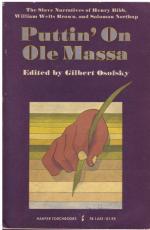|
This section contains 6,029 words (approx. 21 pages at 300 words per page) |

|
SOURCE: “Her Side of His Story: A Feminist Analysis of Two Nineteenth-Century Antebellum Novels—William Wells Brown's Clotel and Harriet E. Wilson's Our Nig,” in American Literary Realism, 1870-1910, Vol. 24, No. 3, 1992, pp. 7-21.
In the following essay, Mitchell argues that Brown and Wilson differed in their depiction of female characters because of their own gender biases and experiences.
The first four novels by African Americans were published after the Fugitive Slave Act of 1850 and after the publication of Harriet Beecher Stowe's consciousness-raising novel, Uncle Tom's Cabin, or Life Among the Lowly (1852).1 Two of these four novels, William Wells Brown's Clotel or The President's Daughter: A Narrative of Slave Life in the United States (1853) and Harriet E. Wilson's Our Nig; or, Sketches from the Life of a Free Black, in a Two-Story House, North. Showing That Slavery's Shadows Fall Even There (1859), examine, as one would expect, the major historical...
|
This section contains 6,029 words (approx. 21 pages at 300 words per page) |

|


